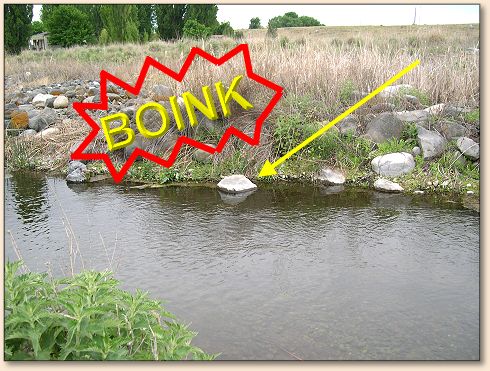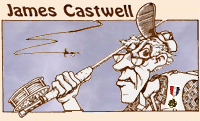|
At the Fish-In last week I had a chance
conversation with one of the guys who was
bemoaning a certain fly he had been fishing.
A dry fly, little thing, about an 18 BWO type.
The conditions at Rocky Ford are varied, some slow ponds,
then small dams, then some tail water leading
into more ponds. This water bubbles out of the
ground (spring creek) and holds a fine head of
rainbow trout. The water contains the normal
weeds and grasses usual to such water.
Fishing the ponds and the moving water provided
the angler with virtually any type of water he
might like. Sometimes the fish are feeding on
emergers, then duns and then spinners. You must
pay a great deal of attention to several factors
to make things work the way you might like.
Certainly the right fly is a must, or at least
darn close. That will change, of course, as the
day moves along. What may have hatched in the
morning in one of the upper ponds will not be
hatching all day long. However the hatch may
move downstream for a few hours as the types
of water change the farther it runs.
Some insects like slower water to hatch from
and to lay their eggs in. Others prefer faster
moving stuff. The trick is to figure out where
the fish will be eating at any given time of
day. This is not too difficult but does take
some time to figure out. During the mid part
of the day feeding slows down as the sun gets
high and bright. Some feeding does occur on
scuds though all through the day. Rather
impressive too, from any of the small bridges
to watch very large fish jam into the vegetation,
twist off a gob, swim a short ways and spit it
out, retaining the scud.
Some die-hards (like me) will continue to fish a
dry all during the day and so need to be even
more aware of what the fish and insects are
doing. These fish get pounded, day after day,
by some fairly decent fly fishers and are not
easily fooled. That part makes it even more of
a challenge to present a fly which might fool
them, and present it correctly. Like... it needs
to float and not drag. And it needs to do it for
a proper distance. It needs to drop ahead of the
vision of the fish (not counting caddis here)
drift exactly into his feeding lane and look
as good as a natural.
With the widely varying conditions it is not
always easy. You are not allowed to wade in
the stream and it's all catch and release.
Gently sloping banks, mostly rocky with
scattered bushes to make sure your back-cast
is very high. Add the nearly high-desert breeze
(wind sometimes too) and you have a more than
interesting outing. With that many conditions
to meet it is often claimed that the fish are
'selective' or uncatchable. And for many, that
is true. Most new to the game come there lured
by tales of huge fish and easy casting conditions
only to go home skunked and humbled. And really,
they need not be.
First the fly must be right, the drift figured
out for each and every cast. Yes...each and every
cast. I watched so many rather fair fly fishermen
casting over and over with zero results. Some
would remember to mend their lines, and most
of the time they were mending in the wrong
directions. They will learn how to improve
on that as they continue to fly fish. They
must learn to look for the tiniest ripples
and wiggles of current on the surface before
they make the first cast. They need to be able
to present a fly to exactly where it must go
and be able to control the drift of the line
and leader during the drift.
I often watched as their fly would land, then
sink immediately, followed by a short jerk on
the line to get it back on top, and then they
tried to follow the fly with the rod tip. You
might get a fish to take once in a while that
way, but the odds are not in your favor. Present
the fly so it stays on top, period. If it does
not, you have done something wrong. Yes, wrong.
Fix it. Do not smack another cast right back
exactly like the last expecting different
results. That is the definition of insanity.
Look again. Study the current seams and flows.
There will be a way to get the fly where it
needs to be and not have it drag or sink.
Sometimes it can be your leader. If you suspect
so, see if lengthening the tippet will give you
more free drift and keep the fly from going
sub-surface on arrival. Some guys like the
leader to sink, others want it to float, two
schools on that, take your pick. I want mine
on top. And I love a tippet that has a lot
of stretch. I can't state it more firmly
than that. Most guys just do not try to make
each and every cast do exactly what they need
it to do. Why not?
Because they do not know what that is supposed
to be, that's why not. It is too easy to dash
out to the stream and start flinging flies.
Getting the line in the air and getting the
fly on the water. Careful thought ahead of
time will separate you from the rest of
them - if you want it to be that way. Does
this make you smarter than they are? No, just
that you know more about what you are there
for and what you are trying to do.
For instance, this. It is approaching mid-day,
the 'bite' seems to be off, not much happening,
no rises, only a few tails wiggling as some are
into scudding. You want to stick with dries.
What should you do? The fish have been feeding
for a while on the top but not now. I look for
some fast water. Anywhere. If I can find some
fish, or even one holding in fast water, why is
he there? Not because he likes to fight the
current for a living. Right, he is feeding...
on something, but he is either feeding or
looking for something to feed on.
What has he been feeding on? Well, for the
past several hours perhaps it was those tiny
dries. In this case, for me, it was. When the
'bite' went off, I moved to the faster part
of the stream, looked for holding fish, offered
them the same bug they had been seeing all
morning (but none on the water now) and gave
them a chance at my fly. I would have had
three for three at one point, but the second
fish missed the fly. I hooked the third fish,
but it decided to preform an acrobatic stunt
and in its enthusiasm jumped head first into
a rock. True, I had witnesses.

Just before that one of the fellows asked me
to check out his rod. It was not a fancy one
but he wanted my opinion on the whole rig, rod,
line and reel. A few of us were around one of
the upper ponds and I said sure, I would be
glad to. I am a sucker for playing with other
guys equipment when I get the chance. The 'bite'
had been off for a while but I saw a bit of fast
water entering the upper end of the pond. Now,
I could have just made a few casts onto the pond
where we were standing, but wondered if there
might be a fish or two in the narrow slip of water.
I walked about a hundred feet or so and after
a few false casts to measure the line in the
air, laid out a cast and let it drop. Nothing
happened. The fish did take the second cast
though. Yes, it was presented right, did not
sink or drag and was exactly where it should be.
And that is the point. I had not fished that
place before, but in just a moment, looked for
the things that might make the difference between
failure and success.
I took some ribbing from them about catching a
fish on the second cast while just checking out
a rod, but, why not? You can do these things too,
if you want to. But you must really want to. ~ JC
|





